Best Time to Plant Fruit Trees By Season & Type
Author: Jen Worst | Editor: Omar Alonso
Review & Research: Jen Worst & Chris Miller
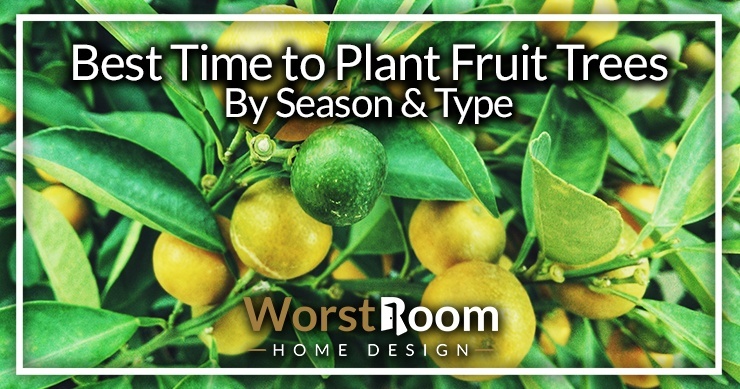
A few months ago my brother and I gave our annual gift to our mom, which is another tree for her small orchard. She was saying that she wanted to have fruit all year round, so I started researching the best time to plant fruit trees.
The problem is there's no good information out there that I could find.
So my goal here is to get all of the details into one spot for the sake of humanity. I'm going to talk about which types of trees you can plant in each season, and deal with the frequently asked questions.
I'll otherwise give some advice on how to best plant all types of fruit trees so they not only survive the transition but thrive for decades to come.
Let's keep it simple to start out so we get a summary and all of the various terminology in our heads. Then we can dig deeper into specific issues and explanations.
I should point out that this information applies mainly to North America and the USA, with special considerations for the warmer USDA plant hardiness zones (7 and above) and the southern states.
When is the Best Time to Plant Fruit Trees?
The three main considerations when planting fruit trees is the current weather, during which season they will bear their fruit, and how you receive them (containerized or bareroot).
Containerized trees, those in pots or balled-and-burlap wrapped where the roots are established in existing soil, can almost be planted any time of the year. Your greatest success will occur if you plant them in months that include the letter "R."
These include September, October, and November (autumn and early winter) or February, March, and April (late winter and early spring).
Bareroot trees, those that are uprooted during dormant seasons when no leaves or fruit are present and whose roots are shaken free of soil and packed in moisture containing materials, are best planted in the months of February, March, April, and occasionally May (late winter and spring).
May is getting a bit late in the season but can work. You should avoid planting bareroot trees in the fall due to the risk of failure explained below.
When to Plant Containerized Fruit Trees & Why
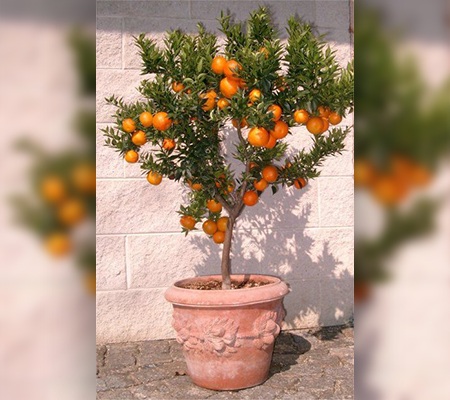
Now for the details. Again, though these can be planted all year round, the best time is any month that contains the letter "R," which means you'll be planting in the fall to early winter or late winter to early spring.
The reason these are far more resilient to when they are planted is because of the fact that they're containerized and not experiencing new growth.
This means that they're already established in soil and when you plant them you'll transplant everything within the container except the container itself.
This means the root system doesn't experience any shock or moisture fatigue (for the most part) because it remains in the same soil without being disturbed.
If you can, you should avoid planting containerized trees in the summer months of May, June, July, and August due to higher temperatures and dry breezes. The lack of moisture in the air and soil can cause moisture stress.
Too much water can cause the same problems, so avoid overly wet times in the spring where water can't drain away and never plant just before or during the times when the ground starts freezing.
When to Plant Bareroot Fruit Trees & Why
Bareroot trees are available to most of us only during the spring due to the "Nursery Cycle." This refers to when bareroot trees are harvested, stored and ensured to be thriving, and then sold to the public.
And because you should plant these nearly immediately, the best time to plant bareroot fruit trees is in the early spring.
When you buy the tree in this condition it will be dormant still for the most part. Getting it in the ground quickly means the roots have a chance to start growing and establishing themselves in the cooler early spring soil.
Letting the roots become strong and larger before temperatures start rising is good because once new growth begins it will have a higher demand on the fertilizer and water contents of the soil around it.
The more mature the root system is, the better it can handle these demands.
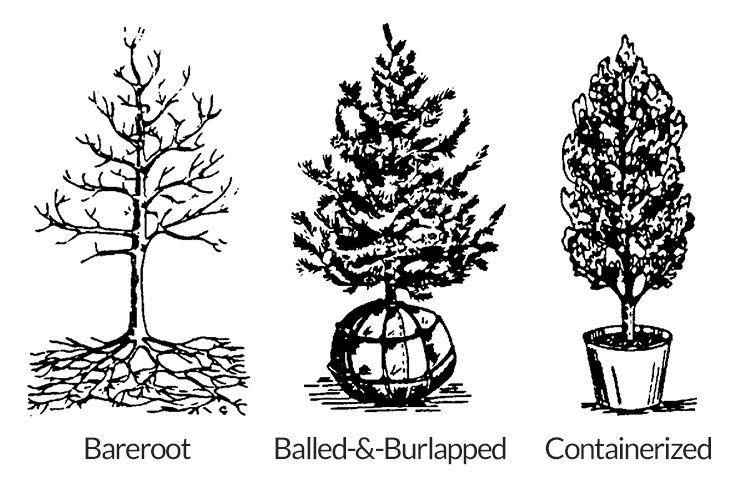
Another option is to plant them in the fall if that's when you buy them, before the nursery stores them for the winter again. In the fall, the root system grows fairly rapidly as demands otherwise slow down due to the tree preparing to become dormant.
The risk here is it won't have had two seasons already to harden itself for the coming winter, so realize there is a risk here. If there's a hard winter or any deep cold snaps, expect for your tree to receive cold damage if not killed. It's a risk you take if you plant in the fall.
Best Time to Plant Fruit Trees By Season
To break it down further, let's look at this by the season in four groupings.
Fall, Winter - Fruit trees can be planted during these months when the trees are dormant, but the early and mid-winter should only be considered if you live in a plant hardiness zone of 8 or above. This would include the South, Southwest, and West Coast.
But still take into consideration the avoidance of planting when the ground is frozen or when snow is forecasted. Fall planting runs a risk of plant harm or death in harsher winters. Late winter can be thought of as early spring if the weather is warm enough.
Early Spring - All fruit trees will perform their best if planted in the early spring, especially in plant hardiness zones of 7 and below where the autumn and winter months are too cold.
The key for early spring (and even late winter) planting is to wait for the soil to be workable and not overly wet. Frost dates are supposedly irrelevant here, but I'd wait till after the last one if it occurs in winter.
Late Spring, Summer & Fall - Containerized trees can do fine in these seasons, but be careful of high heat, dry wind, and low moisture in the soil during the summer.
The fall runs the risk of the plant not acclimating and hardening before winter, leaving it vulnerable to cold damage. Bareroot fruit trees should be planted at the latest in late spring.
Winter - Don't plant your trees during winter, period. There's often too much moisture that can freeze and damage young root systems. Low temperatures and cold wind can cause cold damage and freezing to the trees.
Expect to lose your trees if you try this. The only exception is late winter when the temperature has risen significantly.
USDA Plant Hardiness Zones
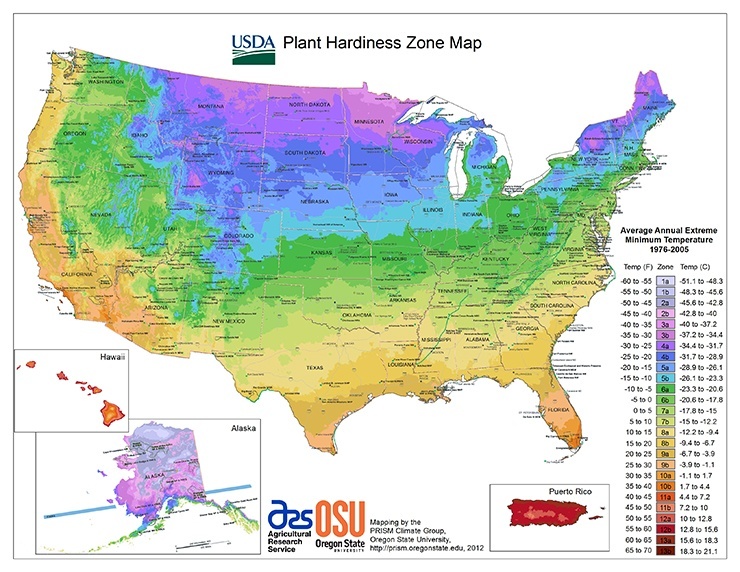
Another way to look at this is how hardy each type of tree is in each hardiness zone. As always, the best option is to plant in the early spring, but if you find yourself looking at the summer or fall based on opportunity, consult the following information.
If a tree is hardy in your zone, you'll have better success in these later seasons.
- Citrus trees (like lemon, lime, & orange) - USDA zones 9, 10, & 11
- Figs & Pomegranates - zones 8 through 11
- Apple trees - zones 3 through 9
- Crabapple trees - zones 3 through 8
- Sweet & sour cherry trees - zones 4 through 8
- European pear trees - zones 5 through 8
- Asian pear trees - zones 9 and 10
- Peach trees - zones 4 through 8
- Plum trees - zones 3 through 8
- Apricot trees - zones 5 through 8
It should be noted that frost-tender trees like citrus trees should be grown in pots and taken inside during the winter in hardiness zones including 8 and below.
Of course there are a lot more types of fruit trees but that's beyond the scope of this article to list all but the most common. There's even more if you consider that some people even consider nut-bearing trees like walnut as a fruit tree.
Frequently Asked Questions
Here are some common questions I've had and have read around the net when investigating this topic.
What Fruits Grow All Year Round?
No fruit tree bears fruit all year round. The goal is to grow multiple types of fruit trees that will bear fruit in different seasons so you're always in stock. For instance, avocado trees will produce fruit in the winter, spring, and summer.
You can pair that with persimmon trees to cover autumn and winter. Toss in a grapefruit tree to reinforce winter and spring, and maybe an elderberry tree for more fun in the sun in summer.
What Fruit Trees Can Be Planted Together?
Some trees thrive better together and multi-planting strategies have been developed. These include apricots and pluots due to enhanced cross-pollination. The same goes with varieties of cherries.
Peaches and nectarines benefit from this strategy as well. Plum varieties can be planted together or mixed with apricots and pluot varieties. And of course, you can plant apple trees of all types together. This strategy often means "four in the same hole."
Do Fruit Trees Need to Be Planted in Pairs?
There are two types of fruit trees: self-pollinating and those that require a pollinator. Self-pollinators include most apricots, most types of peaches, sour cherries, and nectarine trees.
Those that require fruit tree pollination include most apples, plums, sweet cherries, and pear trees. Self-pollinating trees do not need to be planted in pairs, but the others do.
What Happens if You Plant Trees Too Close Together?
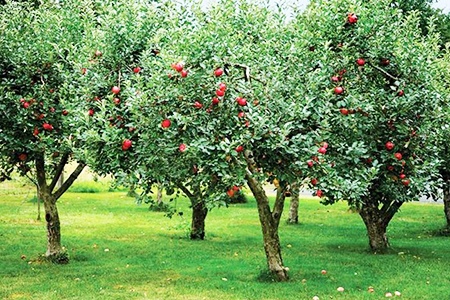
Trees planted too close together compete for sunlight, soil nutrients, and water. They grow taller and skinnier, stretching to reach the sunlight, leaving them weaker physically.
Roots can become entangled, creating a root matrix in which the strongest tree takes in the most water and nutrients, starving the others. The soil is depleted more rapidly, creating a need for more regular water and fertilizer.
What is the Easiest Fruit to Grow?
This is debatable, but I'd say an apple tree is the easiest to grow due to its hardiness across many USDA zones. The second easiest is a fig tree if planted in early spring and given plenty of sun and warmth.
Remember, all trees are flowering plants but not all flowering plants are trees. We're talking about trees here.
When Should Apple Trees Be Planted?
The best time to plant apple trees is in the spring, like all other fruit trees, though the fall can work with the understanding that there are risks if there's a harsh winter ahead.
Don't focus on frost dates in the early spring and late winter. You can plant as soon as the ground is thawed and doesn't contain excessive water.
Can You Plant Fruit Trees in the Fall?
Yes, but there is a risk involved. Fruit trees planted in the spring will have had two seasons to mature their root systems will fare better than those planted in the fall during the winter months.
Can You Plant Fruit Trees in the Summer?
Planting fruit trees in the summer is possible but not advised due to higher temperatures, dry breezes, and low moisture content in the soil. The best time to plant fruit trees is in the early spring.
Fruit Tree Planting Tips
These planting tips are worth mentioning but I want to keep it short. Some parameters you should place around your planting time are to do so when:
- The ground is not frozen.
- Daytime temperatures are above 32ºF and below 90ºF. No freezing and no sweltering heat!
- When the weather forecast is free of any foreseeable extreme rain or snow.
You shouldn't purchase your fruit trees until you are ready to plant them, and then you should do so immediately. Your hole should be dug a few inches deeper than the roots require and twice as wide in diameter so they can have softer soil to spread and grow into.
Trees with standard rootstocks should have the graft union be a few inches above the soil. Interstem trees should have the interstem half above the soil.
Otherwise, the roots should be under the soil but not much extra of the trunk at all, as seen below. It will be okay for some soil to pack around the trunk above ground. You can lay a stick across the hole guide how deep you've placed the rootstock.
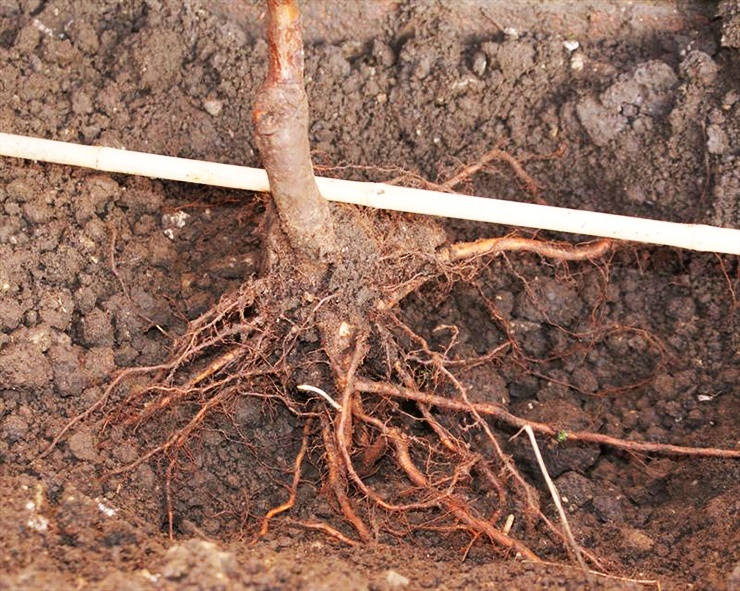
In fact, you want to mound the soil around the trunk to about 3 inches in height and outward about 1 foot in diameter to aid in drainage away from the trunk. This will help you avoid crown rot.
For containerized fruit trees, leave the soil as is and fill in the remaining space with the ground you dug up (same with bareroot fruit trees).
Never add chemical fertilizers, moth balls, fresh manure, or anything else you see people doing that might place undue strain on the root system. Compost can be okay but not more than 1 or 2 shovelfuls.
If you need to prune any broken roots or wildly long ones, cut them cleanly as opposed to breaking them by bending.
Once in place, tamp the soil firmly to remove air pockets in the hole, and then water each hole with around 2 gallons of water so that the soil is thoroughly drenched. Don't prune any branches for at least a couple of seasons.
After care includes keeping moisture levels in the soil high without leaving the roots soaking in excessive wetness. Pruning fruit trees can be done in the next year and should include heavy branches and those that are growing too low to the ground.
Of course, it should be stated that you should know what type of tree you're planting and the fruit they bear, like pome fruits, stone fruits, or nuts. And then consult the USDA plant hardiness zone information above to make sure you're planting in the right season.
Best Time of Year to Plant Fruit Trees
Though we dug through the details above, the best time to plant fruit trees has been agreed upon not only by farmers and gardeners but by scientists who study pomology alike.
Research shows there are advantages to planting as early in the spring as you can, if not late winter, as soon as soil conditions are appropriate.
As a farewell, here's something gross to think about. Fruit are the ripened ovaries of the flowers of trees that also contain the seeds that aid in propagation. Think about what that means. Gross!



